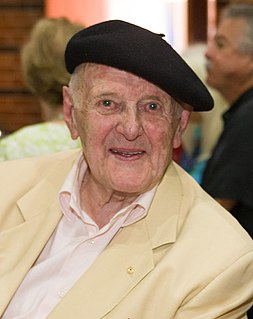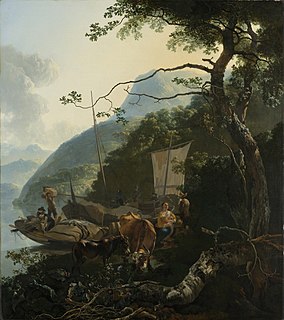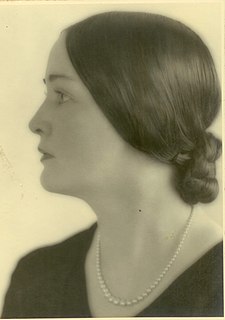
Lionel Hornibrook Jago (1882–1953) was an Australian artist active between 1910 and 1950.

Lionel Hornibrook Jago (1882–1953) was an Australian artist active between 1910 and 1950.
Jago was born in South Australia in 1882. [1]
He studied at Davis Studio, Melbourne and at Julian Ashton Art School in Sydney. [1] [2]
He was also an accomplished violinist. [2]
He moved to Perth in the early 1900s, marrying Christina McTavish in 1912, and worked with the State public service until his retirement in 1945.
Jago exhibited in the inaugural Perth Society of Artists exhibition in 1933. [3] Jago moved to Sydney in the late 1940s, living in Woollahra, and exhibited with the Royal Art Society. [1]
He died in 1953. [1]
After moving to Sydney, Jago was a finalist in the prestigious Sir John Sulman Prize (Art Gallery of New South Wales) in 1948 for Bathers, beaten by Sali Herman’s The Drovers, [4] and in 1950 for Merry-go-Rounds, beaten by Harold Greenhill’s Summer Holiday. [5] He was also a finalist for the 1950 Wynne Prize with Promenade – Watson’s Bay, beaten by Lloyd Rees’ The Harbour from McMahon's Point. [6]
In 2009 the Perth City Council held an exhibition, Modern Visions of the City of Perth, which featured his painting East Perth, 1936 Oil on Canvas 25.0 x 36.5, from the Janet Holmes à Court Collection. [2]
His work is also listed in:

The Archibald Prize is an Australian portraiture art prize, generally seen as the most prestigious portrait prize in Australia. It was first awarded in 1921 after the receipt of a bequest from J. F. Archibald, the editor of The Bulletin who died in 1919. It is administered by the trustees of the Art Gallery of New South Wales and awarded for "the best portrait, preferentially of some man or woman distinguished in Art, Letters, Science or Politics, painted by an artist resident in Australia during the twelve months preceding the date fixed by the trustees for sending in the pictures." The Archibald Prize has been awarded annually since 1921 and since July 2015 the prize has been AU$100,000.

John Henry Olsen, AO, OBE is an Australian artist and winner of the 2005 Archibald Prize. Olsen's primary subject of work is landscape.
The Sir John Sulman Prize is one of Australia's longest-running art prizes, having been established in 1936.

Wendy Sharpe is an Australian artist who lives and works in Sydney and Paris. She is the only child of British parents and has a Russian Jewish heritage. Her father is the writer and historian Alan Sharpe. She counts among her influences paintings by Chaim Soutine and Max Beckmann.[1] She is the winner of numerous major awards including the Archibald Prize, the Sulman Prize, the Portia Geach Memorial Prize and The Adelaide Perry Drawing Prize. She was commissioned by the Australian War Memorial as an official Australian War Artist in East Timor in 1999-2000. Her partner is artist Bernard Ollis.
John Beard is a Welsh artist and painter born in Aberdare, Wales, now based in Sydney, Lisbon and London.

Sam Leach is an Australian contemporary artist. He was born in Adelaide, South Australia. Leach worked for many years in the Australian Tax Office after completion of a degree in Economics. He also completed a Diploma of Art, Bachelor of Fine Art degree and a Master of Fine Art degree at RMIT in Melbourne, Victoria. Leach currently resides in Melbourne. Leach's work has been exhibited in several museum shows including "Optimism" at the Queensland Art Gallery and "Neo Goth" at the University of Queensland Art Museum in 2008, in 2009 "the Shilo Project" at the Ian Potter Museum of Art and "Horror Come Darkness" at the Macquarie University Art Gallery and "Still" at Hawkesbury Regional Gallery in 2010. His work is held in public collections of regional galleries of Geelong, Gold Coast, Coffs Harbour, Newcastle and Gippsland and the collections of La Trobe University and the University of Queensland.
Rosella Namok is an Indigenous Australian artist from Lockhart River, Queensland. Namok was taught art at high school and learned printmaking and other techniques through a community art project in 1997 that led to the formation of a group of artists known as the Lockhart River Art Gang.
Contemporary Indigenous Australian art is the modern art work produced by Indigenous Australians, that is, Aboriginal Australians and Torres Strait Islander people. It is generally regarded as beginning in 1971 with a painting movement that started at Papunya, northwest of Alice Springs, Northern Territory, involving Aboriginal artists such as Clifford Possum Tjapaltjarri and Kaapa Tjampitjinpa, and facilitated by white Australian teacher and art worker Geoffrey Bardon. The movement spawned widespread interest across rural and remote Aboriginal Australia in creating art, while contemporary Indigenous art of a different nature also emerged in urban centres; together they have become central to Australian art. Indigenous art centres have fostered the emergence of the contemporary art movement, and as of 2010 were estimated to represent over 5000 artists, mostly in Australia's north and west.
Peter Sharp is an Australian artist who works predominantly in drawing.
Vladimir Meškėnas was an Australian expressionist painter and portraitist in oil and pastel, who has been a frequent Archibald Prize finalist.

Michael Kmit was a Ukrainian painter who spent twenty-five years in Australia. He is notable for introducing a neo-Byzantine style of painting to Australia, and winning a number of major Australian art prizes including the Blake Prize (1952) and the Sulman Prize. In 1969 the Australian artist and art critic James Gleeson described Kmit as "one of the most sumptuous colourists of our time".
Carlos Barrios is an Australian artist, born Carlos Manuel Barrios Rosa in 1966 in San Salvador, El Salvador, Central America.

Tim Storrier AM is an Australian artist who won the 2017 Doug Moran National Portrait Prize with The Lunar Savant, a portrait of fellow artist, McLean Edwards.
Harold Frederick Weaver Hawkins (1893–1977) was an English painter and printmaker working with the techniques of etching, monotypes, linocuts and woodcuts. He specialized in "ambitious, sometimes mural-sized, modernist allegories of morality for an age of atomic warfare and global over-population." He was active from 1923 to 1972.

Jane Ann Cooper Bennett is an Australian painter.
Aida Tomescu is an Australian contemporary artist who is known for her abstract paintings, collages, drawings and prints. Tomescu is a winner of the Dobell Prize for Drawing, the Wynne Prize for Landscape and the Sir John Sulman Prize, by the Art Gallery of New South Wales.
Kerrie Lester was an Australian artist who was a frequent finalist in the Archibald Prize for portraiture, although she never won the main prize.
Kim Leutwyler, an emerging artist based in Sydney, Australia. She has exhibited her work in multiple galleries across both Australia and the United States. While harboring a collection of pieces that utilize different mediums, she most frequently displays paintings that focus on progressive ideas of gender and beauty, as well as people who identify as queer.

Margaret Coen was an Australian artist, known for her watercolours, paintings of flowers, landscapes and still life works. Her paintings and personal papers are held in national collections.
Joyce (Joy) Vera Mary Ewart (1916–1964) was an Australian painter, graphic artist, and teacher. She was a finalist for the Archibald Prize in 1943, 1944, 1945 and 1948; for the Wynne Prize in 1943, 1945 and 1946; and the recipient of the Mosman Art Prize in 1948. Her works are held by the Art Gallery of New South Wales and have been included in several retrospectives and exhibitions. She mounted solo exhibitions at the Macquarie Galleries in 1942, 1943, 1944, 1948 and 1953. She founded the Workshop Art Centre at Willoughby, NSW where the main gallery bears her name, and which offers the Joy Ewart Scholarship for Year 10 students and the Ewart Art Prize for works by Centre members.